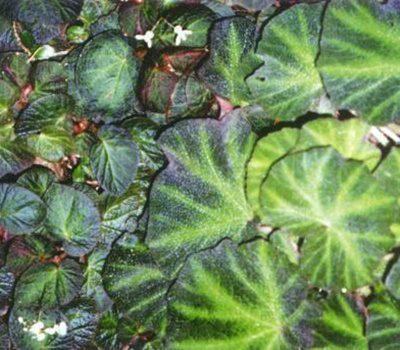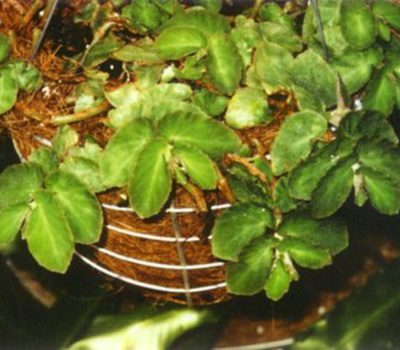Back in the fall of 1999, I was introduced to Begonia U002 not knowing that it had already been around for nearly 20+ years. Since it had a “U” number I thought it was something new. I was a fairly new begoniac and had just been to my first Begonia sales event at the University of South Florida that Dale Sena had organized as part of that spring’s board meeting. A few weeks later our chapter volunteered to host the 2000 convention and we made cuttings of this “new” Begonia. Of this pretty trailing begonia, little did I know…..until now.
Begonia ‘U002’ had been featured on The Begonian cover in 1979, written about in 1981, and talked about on‑line in the yahoo begonia group. It wasn’t until 6 months ago that I found out on this computer group that this wonderful trailing scandent ground cover had been identified as a natural hybrid.
From what I can glean from talking to people and rereading different articles, the story begins back in the mid 1970’s. I heard that seed came in from Brazil as U002. I read that a plant of this U002 was given to Michael Kartuz via Frank Kerin of Pittsburgh via an orchid collector who knew nothing of its origin. Michael grew it and offered it in his catalog, however, he doubted that it was a true species. Patrick Worley saw the plant and in it recognized characteristics of other plants, specifically, what was then known as U003 and U009.
In the February 1981 The Begonian, Brazilian species U003 was the cover photo. This unidentified Brazilian Begonia came from the garden of Roberto Burle Marx (landscape architect in Rio de Janeiro) via Gilbert Daniels. This Begonia species has a dark green leaf with a postulate surface and has a distinct light green color radiating from the center, edged in red. It also has tiny white flowers and is now know as Begonia soli-mutata.
The second species, U009, was also on a The Begonian cover later that same year in the month of May. Like B. soli-mutata, this was from Mr. Marx’s garden as well and, therefore, most likely Brazilian even though there was no exact record of it’s origin. In 1974 Mr. Marx gave the plant to Dr. Gilbert Daniels (past president of the American Horticultural Society and past director of the Hunt Botanical Institute). U009 has small felted leaves that are dark green with light green markings radiating along the middle veins. Leaves are close together and attached to reddish trailing stems. The flowers are white and U009 is now known as Begonia thelmae, named after Thelma O’Reilly. Back in 1976 several ABS members were visiting Dr. Daniels and his greenhouses in Pittsburgh and were given cuttings of this trailing begonia.
My question at this point is, after all these years, has anybody ever found these begonias again in the wild, or was this the last possible plant that just happened to be in the Marx garden? Do people ever go back to re-explore an area to try and verify what is still there? Perhaps someone has been there and would like to do an article on this aspect of begonia hunting in Brazil?
Meanwhile, this brings us back to B. U002 and its resemblance to B. U003 and U009. Notice in the pictures how the three plants resemble one another. Patrick Worley decided to cross these two species around 1978 and when he did so, came up with many fairly uniform seedlings that grew up to be just like U002. The FI seedlings varied slightly in leaf size and height but this is common in species to species crosses. Byron Martin of Logee’s Greenhouses duplicated this cross and came to the same conclusion. Patrick then named this cross B. ‘Manaus’ after the Brazilian city of Manaus.
Begonia U002 seems to like a lot of humidity around it. I have tried growing it in a hanging basket, but it only gets leggy for me. One day a small piece of it fell out of its basket and just started running along the ground searching for new places to explore. It now grows right over all the old oak leaves that fall in my flower beds and over the occasional limestone rock in its way. It has established itself in several areas of my yard as a compact ground cover and blooms all year long. So, until it freezes in West Palm Beach, I guess this little Begonia will just keep trailing along!
Below left Johanna’s photo shows her B. U002 and B. soli-mutata growing side by side and below right is her B. themae in a basket.



